Sr. Bones - 2010
'09 maps for:
Bea
--
Buck -- Caley --
Claws --
Conomo --
Hix --
Hudson 09 -- Isabel --
Katy -- L.R. --
Moffet --
Mr. Hannah --
Ozzie --
Penelope
--
Rafael
2010 maps for: Belle -- Buck --
Gunny --
Hudson --
Mr. Hannah --
Neale --
North Fork Bob
--
Penelope --
Sanford
-- Sr. Bones --
Thatch
2011 maps:
Belle --
Buck --
Henrietta --
Katbird
-- North Fork Bob --
Pemi --
Saco --
Sanford --
Sr. Bones --
Snowy --
Thatch -- Tucker
2012 maps: Art --
Belle --
Bridger --
Chip --
Cutch --
Jill -- North Fork Bob --
Rammie --
Snowy --
Sr. Bones -- Thatch
2013 maps: Art --
Belle --
Bridger --
North Fork Bob --
Rammie --
Snowy --
Sr. Bones
Osprey
main page --
Migration
page --
Migration09 --
Migration10 --
Migration 11 --
Migration 12 --
Migration 13 -- Home
Page
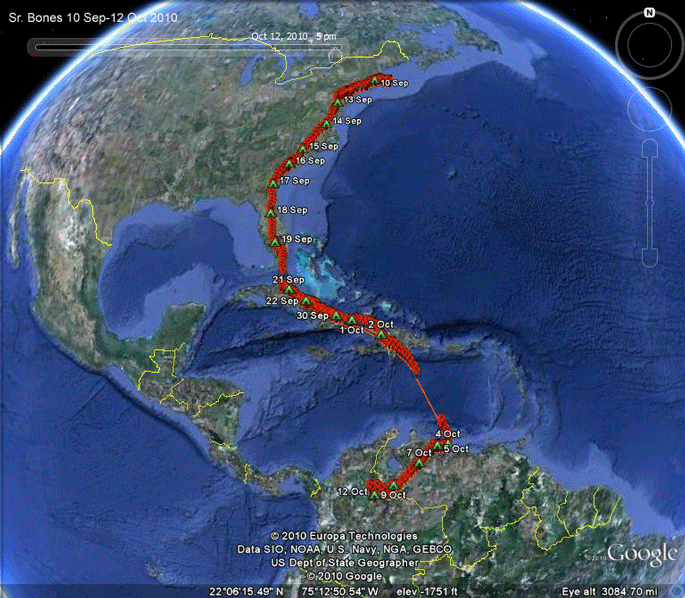 |
10 Sep-12 Oct 2010: Sr. Bones is on his fifth trip south,
although the first one we've been following. He has taken the totally
conventional route, staying over land as much as possible. When he got
to Venezuela, he worked his way west along the coast looking for a gap
in the mountains that fall into the Caribbean. Once past the mountains,
he set his compass for somewhere in Colombia and met the
Cordillera Oriental (eastern) of the Andes. He's now 175 mi (282 km)
northeast of Bogota, 3629 miles (5840 km). Scroll down for detailed maps. Jump to the start of migration. |
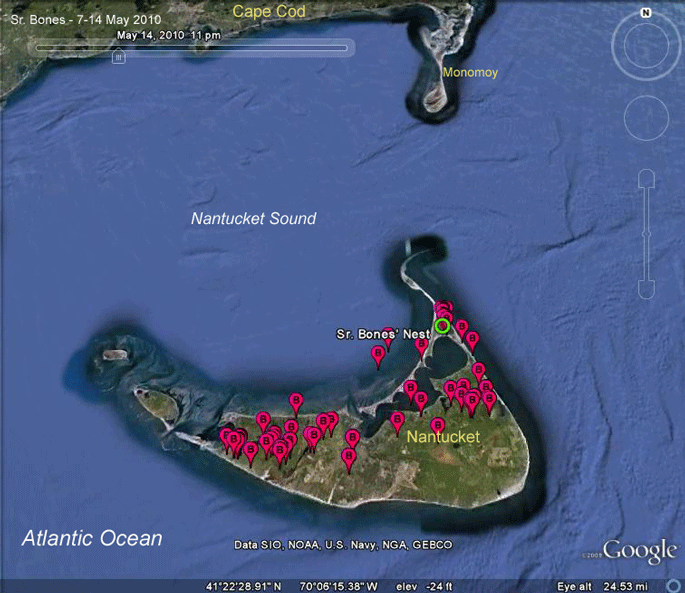 |
7-14 May 2010: The first week. |
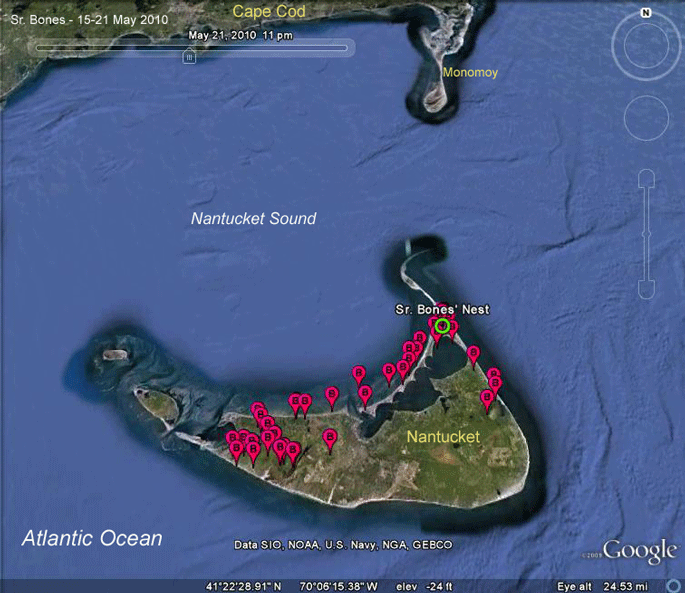 |
15-21 May 2010: Most of Sr. Bones' hunting this week was along the harbor and at the western end of the island. |
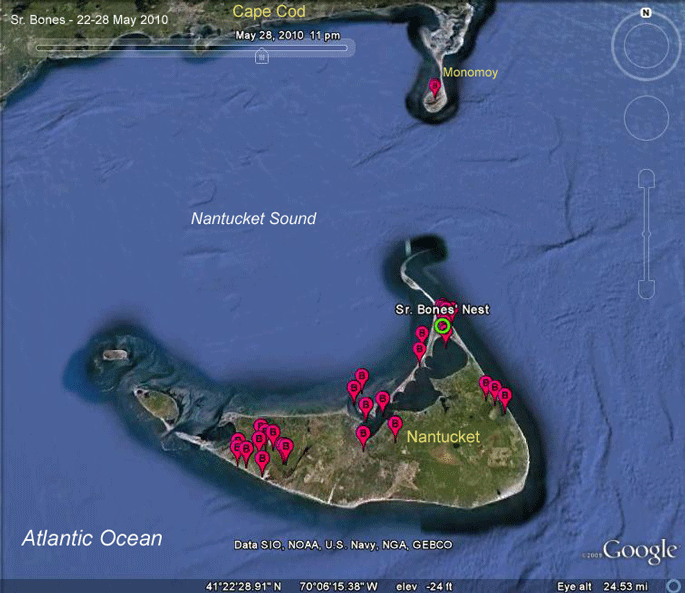 |
22-28 May 2010: Pretty much the same pattern, but for a side trip up to Monomoy on the 28th. Sr. Bones spent a couple of hours up on this sandy point at the elbow of Cape Cod. Monomoy is 14 mi (23 km) north of Sr. Bones' nest. |
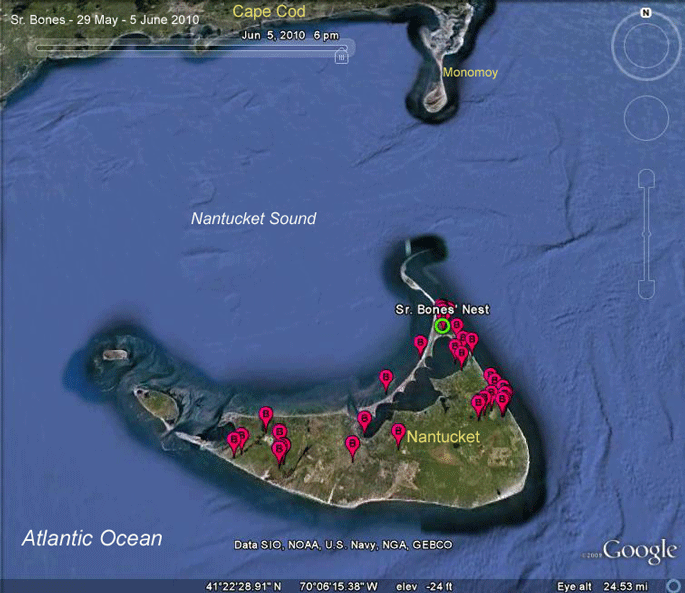 |
29 May-5 June 2010: Sr. Bones did a bit of fishing at Long Pond on the western side of the island, but spent most of his fishing time at Sesachacha Pond (the eastern-most cluster of points). |
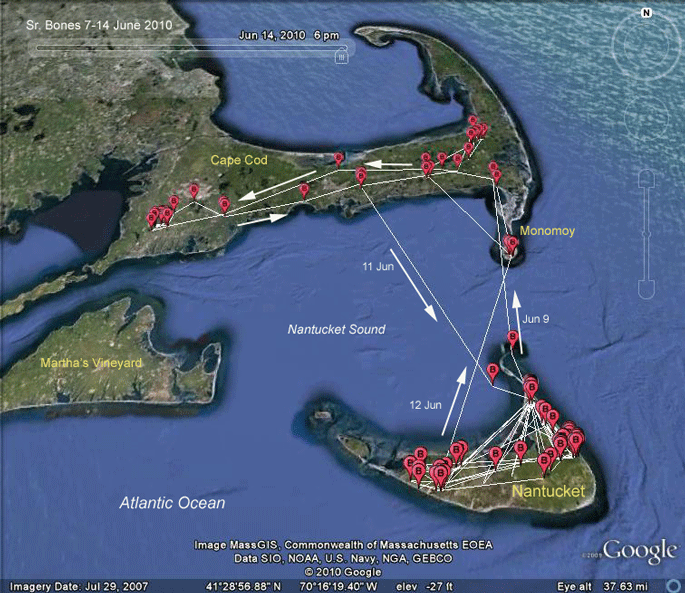 |
7-14 June 2010: Sr. Bones' nest has failed, probably because he
couldn't catch enough fish to feed his brood. Without the responsibility
of young, he is free to wander more widely in search of food. Like
several of our tagged adults on Martha's Vineyard, when the fishing is
bad on their islands, they head over to the mainland in search of some
fresh-water fishing. Sr. Bones went to the Cape on the 9th, came back on
the 11th, and then headed back to Monomoy on the 12th. While he no longer has young to feed, he does have a nest to defend, so forays to the Cape for fishing will be interspersed with trips back home to keep the "no trespassing" sign up. He doesn't want any young birds looking for a nest to find his abandoned. |
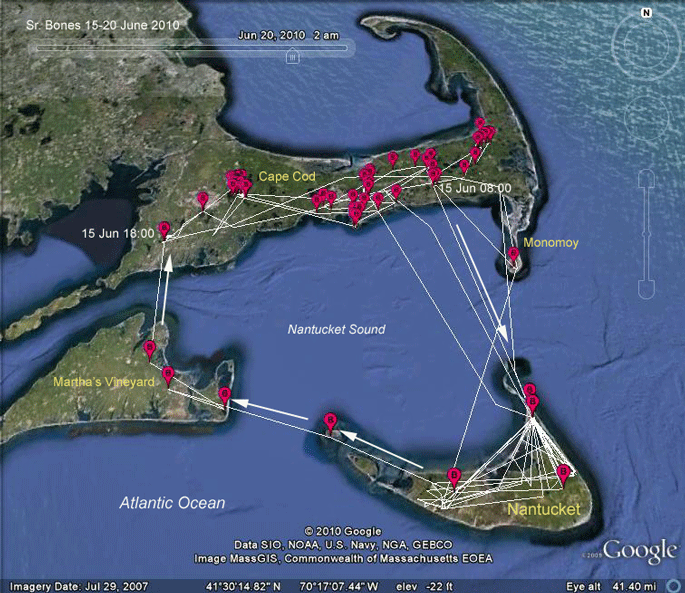 |
15-20 June 2010: On the 15th, Sr. Bones left the Cape, made a cameo
appearance at his nest for an hour or 2 and then flew over to the
Vineyard, and wound up the day back on the Cape, just north of Falmouth. The cluster of locations just west of "Cape Cod" on the map is at a series of ponds near the Otis Air National Guard Base, where Sr. Bones' neighbor Mr. Hannah, spent a few days waiting out a storm on his trip home back in March. |
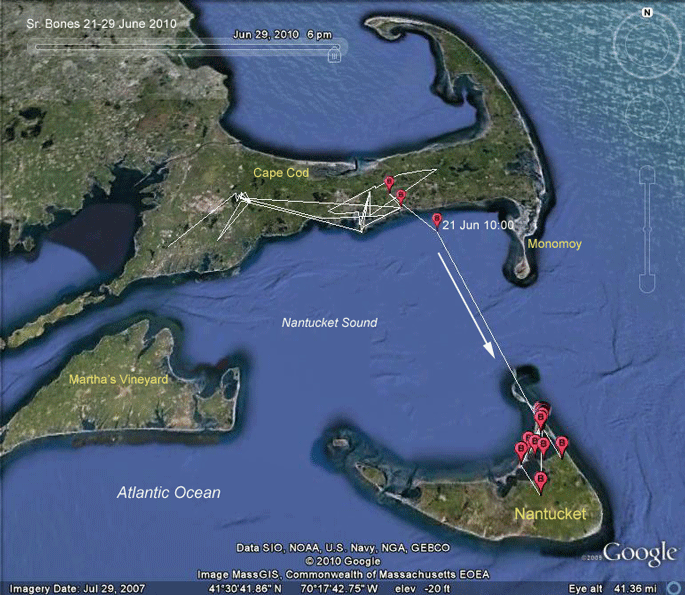 |
21-29 June 2010: Sr. Bones is back on Nantucket, hanging around his nest. |
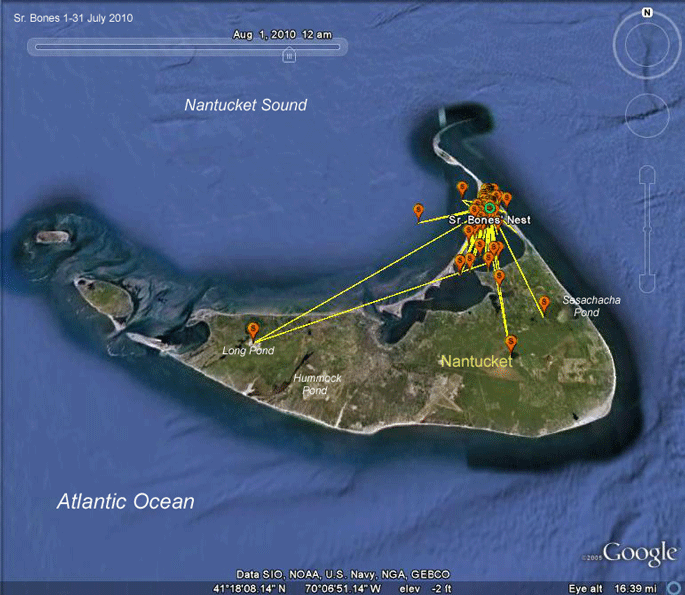 |
1-31 July 2010: Sr. Bones is pretty much settled down, apparently the fishing is now pretty good around his nest. |
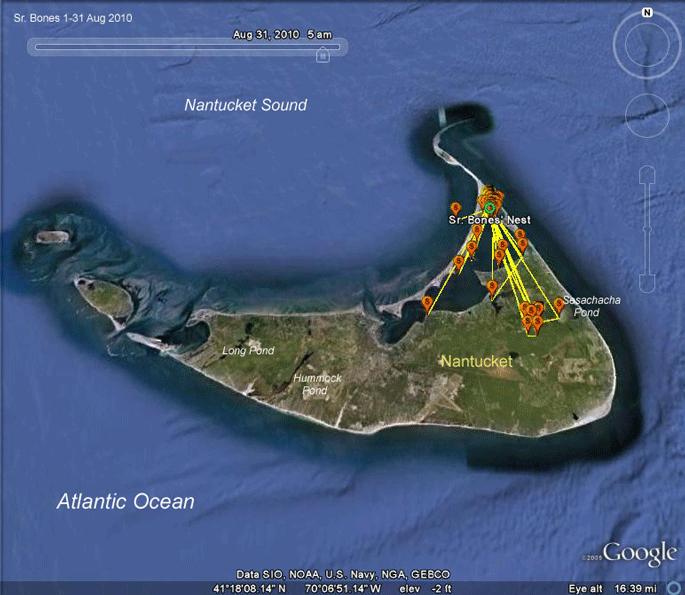 |
1-31 Aug 2010: With no young to feed and plenty of fishing in the front yard, Sr. Bones is just biding time, waiting for the combination of shortening days and good winds out of the north to begin his migration south. Although we don't know where he's going, he does. He was born in 2005, so his first trip south would have been that fall. He would have returned to Nantucket (or at least New England) in 2007. This will be his fourth trip south. |
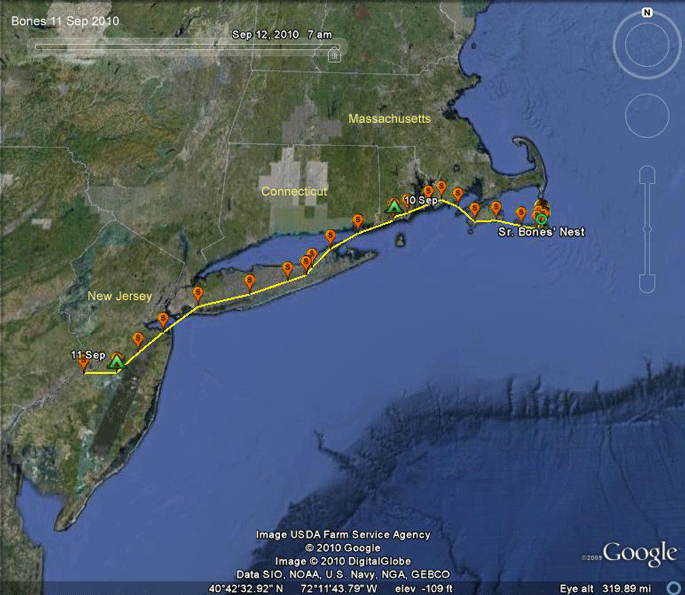 |
10-11 Sep 2010: Winds out of the north and the shorter days of late
summer have triggered Sr. Bones' instinct to migrate. He left Nantucket a little after 11:00AM on the 10th and flew 87 miles before settling down for the night in southwestern Rhode Island. He got a very early start on the 11th, taking off around 06:00 (unusual in our experience for a migrating bird to start so early). He stopped in Long Island (very close to North Fork Bob's nest) for about 3 hours, presumably fishing the western end of Peconic Bay. After his lunch break (also unusual) he pushed on through the rest of Long Island and finally settled down for the night in central New Jersey. He covered 180 miles on the 11th. |
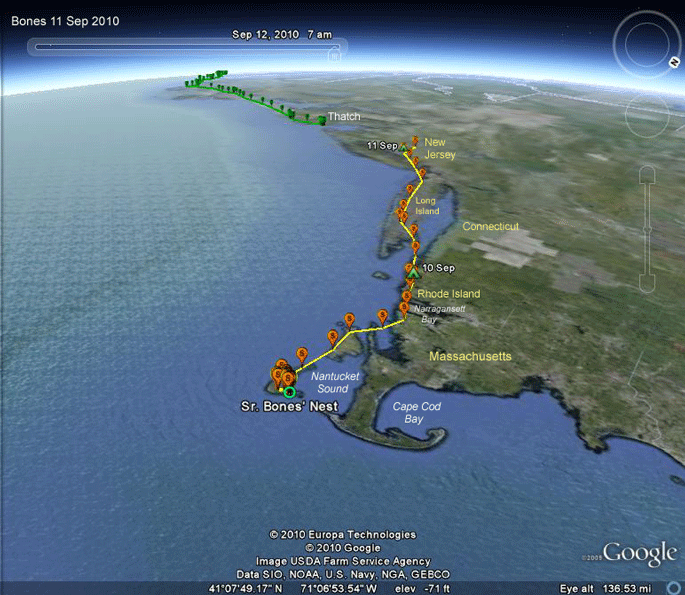 |
10-11 Sep 2010: Here's the satellite perspective of the first couple
of days of Sr. Bones' fifth migration (but the first we're following). This is pretty conventional-over land as much as possible. His neighbor Mr. Hannah likes to cut the corner a bit and head out over the water to New Jersey. Up on the horizon we can see the track of Thatch, our Delaware juvenile, who took off about the same time as Sr. Bones. |
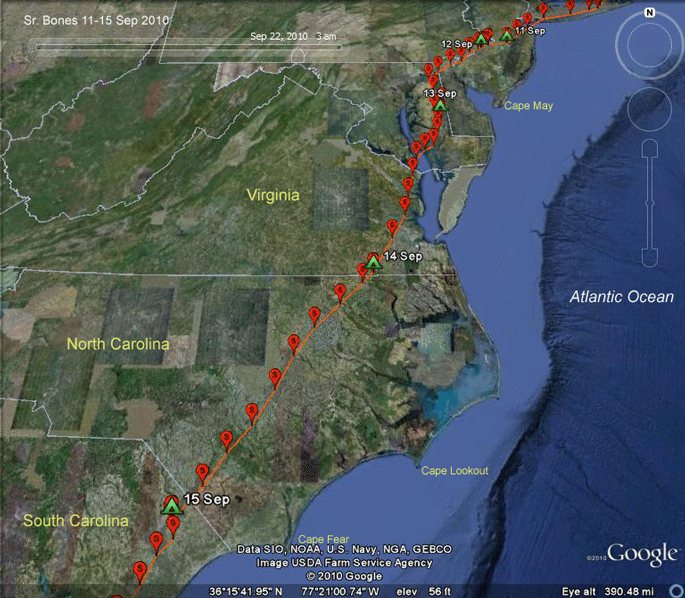 |
11-15 Sep 2010: Winds probably out of the east a bit would have
pushed Sr. Bones inland, so the hawk counters at Cape May and the Cape
Henlopen hawk watches would have missed this one. This is pretty straightforward migration. Good weather and he's clipping along at an average of 133 miles/day (214 km/day). On the 14th he roosted on the headwaters of the Chowan River in southern Virginia. He made a leisurely departure on the 15th, just around 10AM, probably after some fishing on the morning of the 15th, or waiting for thermals to build up. At the end of this 214 mile leg of his trip he was way up there-around 5,400 ft above sea level. |
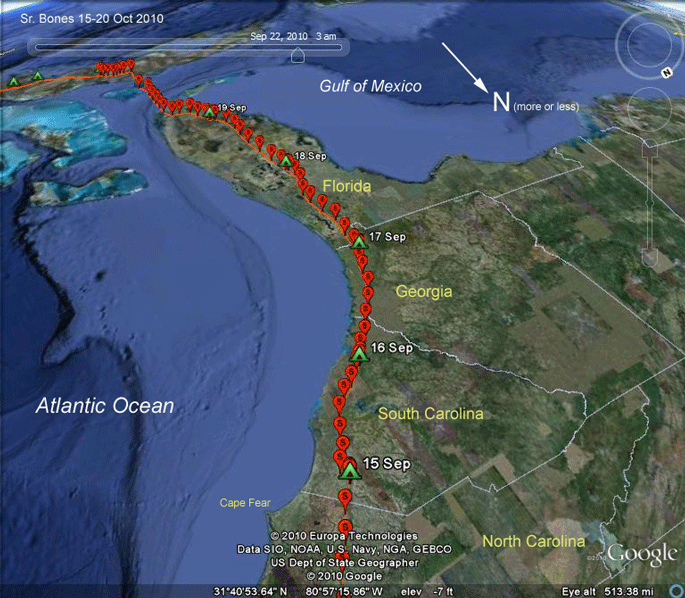 |
15-19 Sep 2010: Weather's fine and Sr. Bones is covering lots of
ground. 143 miles (228 km)/day is a good pace. On the 18th he roosted in the appropriately named Lake County just west of Orlando and then on the 19th he spent the night in the Everglades. |
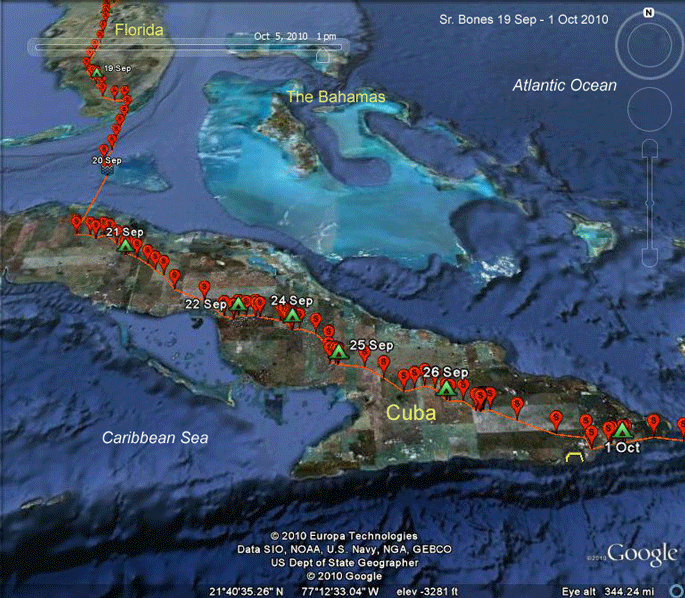 |
19 Sep - 1 Oct 2010: No moss is going to grow on this boy. He left
the Everglades around 9:30AM, crossed the Florida Keys around 3:30PM and
got to Cuba a little over 7.5 hours later--around 11PM. The next five days were more of the same. He finally ran into some bad weather on the 28th, when he found himself at the same reservoir where our Vineyard youngster, Conomo, spent a year and a half back '07/'08. The weather broke on the 1st and he got back to the work of getting to someplace down in South America (probably). |
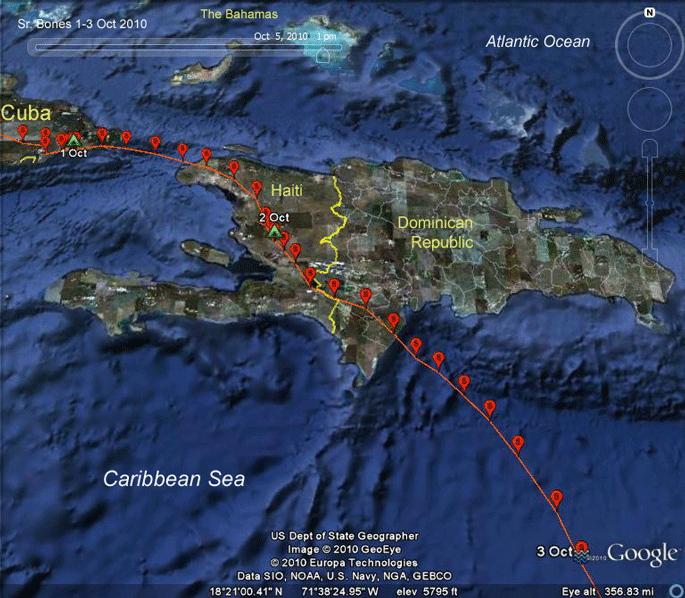 |
1-3 Oct 2010: Given the number of birds we've had shot on
Hispaniola, I always like to see Ospreys go through Haiti and the
Dominican Republic in the minimal amount of time possible, like Bones
did here. He started his big day of migration around 9AM on the 3rd and headed out over the Caribbean around 3PM. Seven hours later he was 165 miles (267 km) off shore, averaging 23 miles (39 km)/hour. |
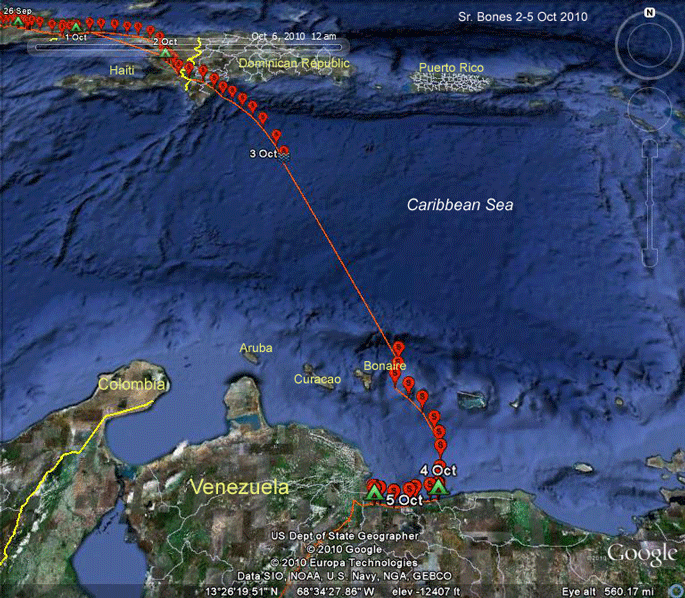 |
1-5 Oct 2010: No problem for this Osprey crossing the Caribbean.
(The next week we would lose 3 birds in a week just as they were about
to arrive in South America.) He was out over the water for about 21 hours (27 in the air) when he seems to have made a detour around a nice little atoll (Anyone out there old enough to remember Rocky and Bullwinkle's adventures on "Nothing Atoll"?) where he could have rested if he wanted to. He was about 500 ft above sea level and only 12 miles west of the island at around 3PM, so he certainly could have seen it. For this leg of his journey, he was in the air about 34 hours and covered 698 miles (1,124 km), averaging 21 miles (33 km)/hour. |
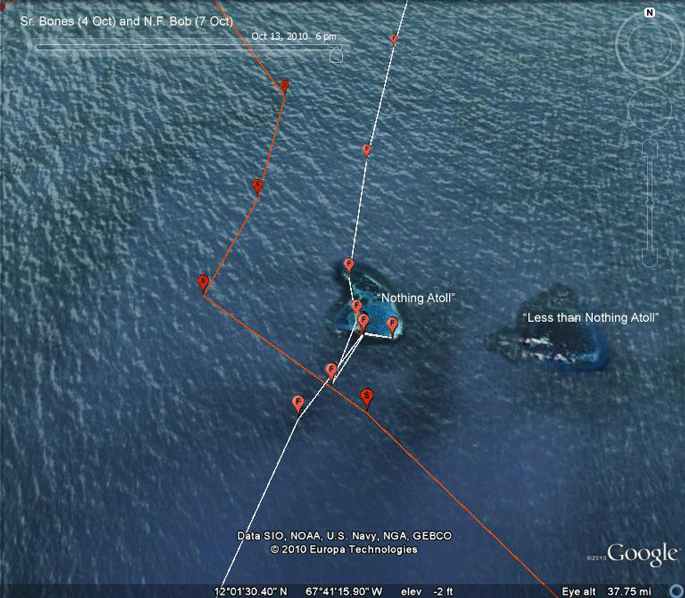 |
4 Oct (Sr. Bones) and 7 Oct (North Fork Bob) 2010: Sr. Bones'
reaction to these little islands--"Atolls, I don't need no stinkin'
atolls!" Jokes aside, it is weird that he detoured around a potential
resting spot after about 27 hours of non-stop flapping (21 of those over
open water). And, no, those aren't the real names of those tiny islands. |
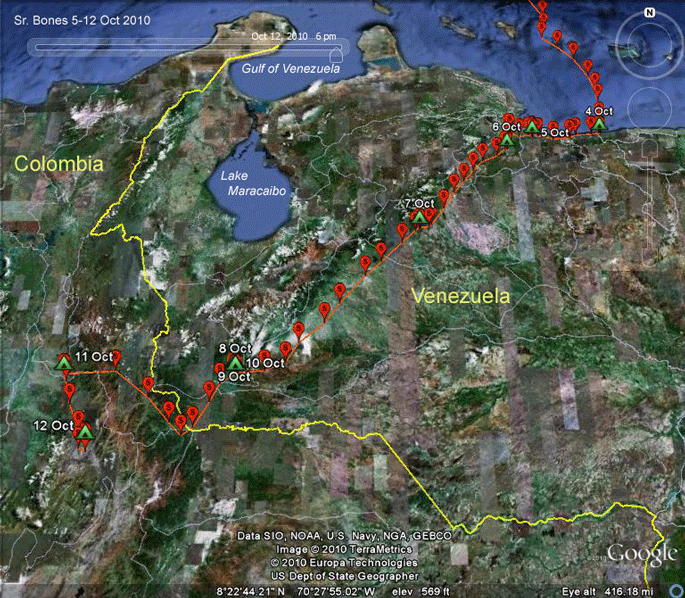 |
4-12 Oct 2010: Arriving from the north at Venezuela's coast, one is
confronted with a really impressive mountain range that pretty much
erupts from the sea. Ospreys that make landfall here will usually go one
way or the other along the coast until they find a gap in the mountains
to avoid a big climb. Sr. Bones did this and once he made it past the
coastal range, he clearly had his compass set for someplace he's been
before. This is navigation. On the 8th he stopped for a couple of days, probably waiting for weather, and then worked his way over the eastern range of the Andes (the Cordillera Oriental) and down into the Magdalena Valley. I'd have to guess he's not at his final destination yet. Through the 12th of October, he has flown about 3,600 miles (5,800 km). He has been migrating for 33 days, 6 of which were non-migration, waiting for the weather days. For his migration days, he's averaged 134 miles (216 km)/day. Which is pretty much the overall average for all our Ospreys followed to date. |
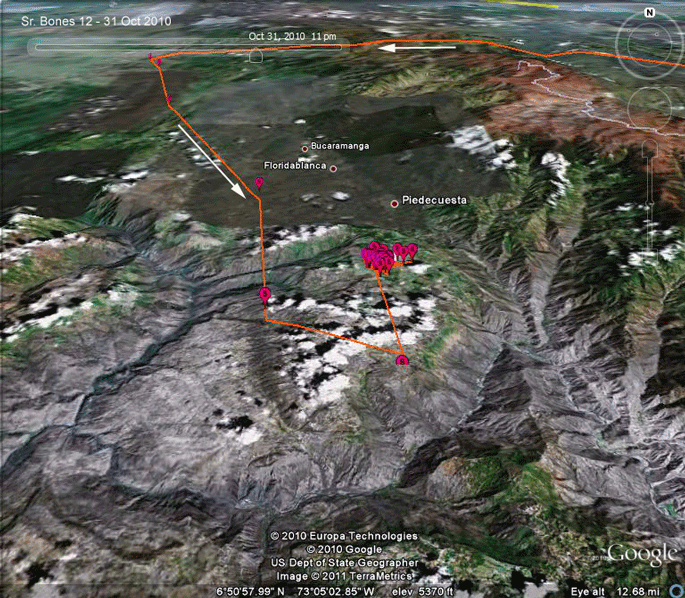 |
12-31 Oct 2010: Sr. Bones climbed from an
elevation of about about 1,800 ft down in the Magdalena Valley to almost
a mile above sea level (5,250 ft/1600 m) up in the eastern Cordillera. This is a most unusual wintering location. |
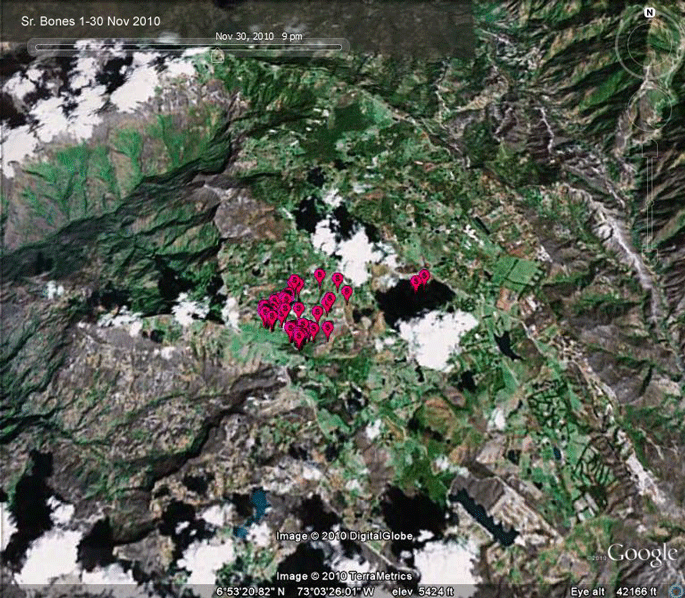 |
1-30 Nov 2010: Sr. Bones has definitely set anchor here, high in the
Andes. Frustratingly, the resolution of the satellite images for this
area is poor, so zooming in much more than this doesn't tell us much
about his location. There's clearly some agriculture down in the valley, and the spot he's in now has some sort of village (it gets a name, La Granja, in Google Earth), but it's tiny. |
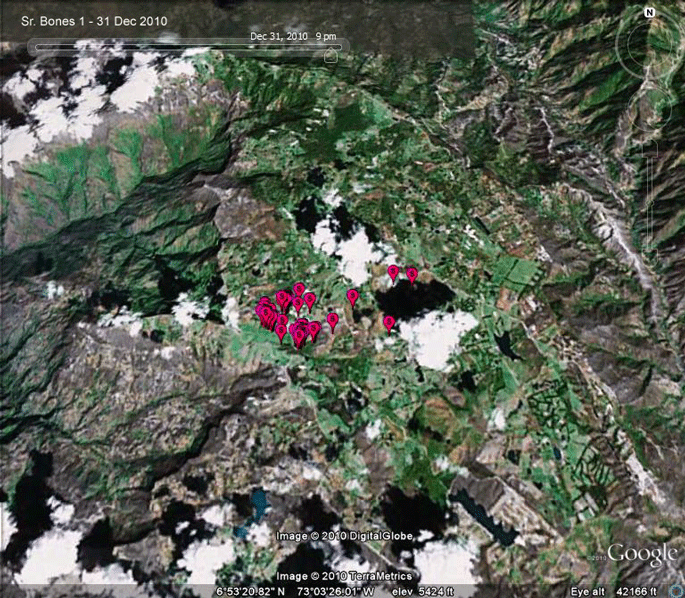 |
1-31 Dec 2010: This is the tightest cluster of locations we've ever
seen from a wintering Osprey. Almost all his points are in and area no
more than 0.6 miles (1 km) across. Hard to believe he's found such a rich source of fish way up in the mountains. Maybe there's a little reservoir there for the folks down in the valley. |
Birds of Prey page -- Osprey main page -- Migration page -- Home Page